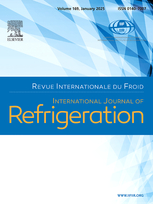
IIR document
Two-phase heat exchange for new refrigerants and their mixtures.
Author(s) : STEPHAN K.
Type of article: Article, IJR article
Summary
Boiling and condensation heat transfer coefficients of mixtures are often considerably lower than those of the pure components. The reduction depends mainly on the difference between dew- and bubble-point temperature for a given concentration. In forced-convection boiling, these effects are well described by a model, tested with over 13,000 data points which also applies to refrigerant mixtures. When vapours are condensed, the usual assumption of film condensation often does not hold for mixtures, particularly at condensation rates that are not too large. Measured heat-transfer coefficients are then larger by up to a factor of 4 than those of film condensation. In the case of larger condensation rates, subcooling of the vapour phase with subsequent fog formation can occur.
Available documents
Format PDF
Pages: 198-209
Available
Public price
20 €
Member price*
Free
* Best rate depending on membership category (see the detailed benefits of individual and corporate memberships).
Details
- Original title: Two-phase heat exchange for new refrigerants and their mixtures.
- Record ID : 1996-0063
- Languages: English
- Source: International Journal of Refrigeration - Revue Internationale du Froid - vol. 18 - n. 3
- Publication date: 1995/03
Links
See other articles in this issue (7)
See the source
Indexing
- Themes: Blends
- Keywords: Calculation; Heat transfer; Simulation; Mixture; Refrigerant; Condensation; Boiling
-
Prediction of the condensation and boiling char...
- Author(s) : SAMI S. M., SCHNOTALE J., SMALE J. G.
- Date : 1994
- Languages : English
- Source: Int. J. Energy Res. - vol. 18
View record
-
Prediction of in-tube condensation heat transfe...
- Author(s) : JIN D. X., KWON J. T., KIM M. H.
- Date : 2003/08
- Languages : English
- Source: International Journal of Refrigeration - Revue Internationale du Froid - vol. 26 - n. 5
- Formats : PDF
View record
-
Forced convective condensation and boiling of t...
- Author(s) : SAMI S. M., TULEJ P. J., SONG B.
- Date : 1994
- Languages : English
- Source: Int. J. Energy Res. - vol. 18
View record
-
SUPPRESSION OF NUCLEATE BOILING OF PURE AND MIX...
- Author(s) : ROSS H. D., RADERMACHER R.
- Date : 1987
- Languages : English
- Source: Int. J. multiph. Flow - vol. 13 - n. 6
View record
-
A proposal numerical technique for the calculat...
- Author(s) : RANGEL H. J., BOGOYA D. M., BEJARANO P. J.
- Date : 1993
- Languages : English
- Source: Lat. am. appl. Res. - vol. 23 - n. 2
View record
